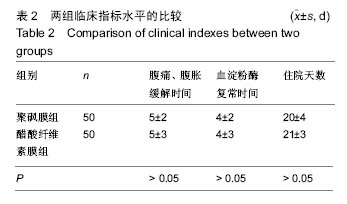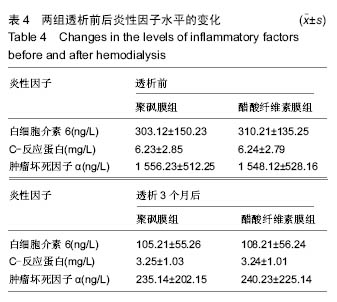| [1]罗洋,卞维静.外周血单个核细胞凋亡评价血液透析膜生物相容性的实验研究[J].中国血液净化, 2008,7(4): 195-197.
[2]陈波,周青山,张静静,等.重症胰腺炎中血液透析膜的应用价值[J].中国医药导报,2013,10(28):20-22,33.
[3]卞书森,张福港,李晓东,等.血液透析膜的生物相容性研究进展[J].中国血液净化,2006,5(4):205-207.
[4]谢红浪,季大玺.不同透析膜的生物特性及临床应用[J].肾脏病与透析肾移植杂志,2004,13(4):374-377.
[5]张伟明.REXEED<'TM>系列聚砜膜高通量透析器性能评价的临床和实验研究[D].上海交通大学,2008.
[6]曹宁.肾功能衰竭患者采用不同血液透析膜材料的生物相容性对比分析[J].中国组织工程研究, 2012,16(25): 4727-4734.
[7]陈昕丽.透析膜的生物相容性对血清细胞因子的影响[J].中国血液净化,2004,3(3):141-143.
[8]Wald R, Shariff SZ, Adhikari NKJ, et al. The Association Between Renal Replacement Therapy Modality and Long-Term Outcomes Among Critically HI Adults With Acute Kidney Injury: A Retrospective Cohort Study. Crit Care Med.2014;42(4):868-877.
[9]王文,王宝仁,孙特,等.不同类型透析膜对维持性血液透析患者血清C-反应蛋白水平变化的影响[J].武警医学, 2004,15(12):891-893.
[10]田津生,张怡静.不同透析膜对血透患者血清C反应蛋白、白细胞介素-6、白细胞介素-8和白蛋白的影响[J].临床内科杂志,2012,29(1):40-42.
[11]潘碧霞,刘国辉,叶爱玲,等.不同材料血液透析膜的生物相容性及溶质清除能力的比较研究[J].中国医药指南, 2014, 12(21):97-99.
[12]Sikder J, Pereira C, Palchoudhury S, et al. Synthesis and characterization of cellulose acetate-polysulfone blend microfiltration membrane for separation of microbial cells from lactic acid fermentation broth. Desalination. 2009;249(2):802-808.
[13]石磊.不同透析膜材料在维持性血液透析过程中的生物相容性[J].中国组织工程研究与临床康复, 2010,14(34): 6453-6456.
[14]杨立峰,柯军,颜林,等.血液透析器的生物相容性研究及其临床应用现状[J].临床医学工程,2012,19(2):320-322.
[15]李远,赵战云,郭冀鲁,等.不同透析膜对维持性血液透析患者血清C-反应蛋白水平的影响[J].潍坊医学院学报, 2010, 32(6):439-441.
[16]于金刚,蒋新宇,焦飞鹏,等.血液透析膜的应用及其改性研究进展[J].科技导报,2013,31(5):98-105.
[17]Okita Y, Okahisa T, Sogabe M, et al. Low-volume continuous hemodiafiltration with nafamostat mesilate increases trypsin clearance without decreasing plasma trypsin concentration in severe acute pancreatitis. ASAIO J.2007;53(2):207-212.
[18]郭杰峰,梁静.不同维生素C使用方法下醋酸纤维膜透析器生物相容性的研究[J].中外健康文摘, 2014,10(7): 159-160.
[19]郑斌,张萍,何强,等.不同纯度的透析液对维持性血液透析患者微炎症状态的影响[J].浙江医学, 2012,37(7): 538-539.
[20]于黔,赵素云,蒋文勇,等.不同透析膜和不同血液净化方式对血液透析患者炎症介质的影响[J].临床肾脏病杂志, 2011,11(3):116-116.
[21]郭增革.纤维素/聚醚砜共混中空纤维透析膜的制备与性能研究[D].天津工业大学, 2012.
[22]王艳璇.低通量聚砜膜进行血液透析对患者血清IL-1β、C反应蛋白、补体C3、C4及中性粒细胞、单核细胞、血小板的影响[D].中国医科大学,2010.
[23]刘俊英.血液透析膜的生物相容性与透析并发症[J].中国组织工程研究与临床康复,2009,13(3):557-560.
[24]孟娟.血液透析中血流动力学与透析膜生物相容性对血管内皮细胞的影响[D].首都医科大学,2007.
[25]Kurita R, Yabumoto N, Niwa O, et al.Miniaturized one-chip electrochemical sensing device integrated with a dialysis membrane and double thin-layer flow channels for measuring blood samples. Biosensors Bioelectron 2006;21(8):1649-1653.
[26]钟一红,徐元钊,丁小强,等.血浆白细胞介素8水平对透析膜生物相容性的评价[J].复旦学报(医学版), 2002,29(2): 91-93,97.
[27]刘静,丰玲,张东亮,等.四种不同膜材料透析器生物相容性的临床研究[J].中华肾脏病杂志,2011,27(4):253-258.
[28]Ishihara K, Miyazaki H, Kurosaki T, et al.Improvement of blood compatibility on cellulose dialysis membrane. III. Synthesis and performance of water-soluble cellulose grafted with phospholipid polymer as coating material on cellulose dialysis membrane. J Biomed Mater Res B.1995;29(2):181-188.
[29]Yamamoto K, Kobayashi K, Endo K, et al. Hollow-fiber blood-dialysis membranes: superoxide generation, permeation, and dismutation measured by chemiluminescence. J Artif Organs. 2005;8(4):257-262.
[30]刘静.不同膜材料透析器生物相容性及溶质清除能力的临床研究[D].首都医科大学,2011.
[31]Nakata H, Sugitani S, Yamaji S, et al. Pancreatitis with pancreatic tail swelling associated with incretin-based therapies detected radiologically in two cases of diabetic patients with end-stage renal disease. Intern Med. 2012;51(21):3045-3049..
[32]赵天然.不同透析膜对血液透析患者IL-18表达水平的影响[D].河北医科大学,2006.
[33]Abramova N. Application of an ion-selective field effect transistor with a photocured polymer membrane in nephrology for determination of potassium ions in dialysis solutions and in blood plasma. Talanta.2000; 52(3): 533-538.
[34]Gika HG, Michopoulos F, Divanis D, et al. Daptomycin determination by liquid chromatography-mass spectrometry in peritoneal fluid, blood plasma, and urine of clinical patients receiving peritoneal dialysis treatment. Anal Bioanal Chem. 2010;397(6):2191-2197.
[35]Borazan A, Ustun H, Yilmaz A. The effects of hemodialysis andperitoneal dialysis on serum lipoprotein and C-reactive protein levels. J Int Med Res. 2003;31(5):378-383.
[36]Schindler R, Boenisch O, Fischer C, et al. Effect of the hemodialysis membrane on the inflammatory reaction in vivo. Clin Nephrol.2000;53(6):452-459.
[37]冯德辉.血液透析膜材料在重症胰腺炎领域的应用[J].中国组织工程研究与临床康复,2011,15(29):5417-5420.
[38]Pertosa G, Grandaliano G, Gesualdo L, et al. Clinical relevance of cytokine production inhemodialysis. Kidney Int. 2000;58(76):s104-s111.
[39]Chatenoud L, herbelin A, Beaurain G, et al. Immune deficiency of the uremic patients. Adv Nephrol. 1990; 19:259-274.
[40]田津生,XU Jin-sheng,张怡静,等.不同透析膜对血透患者血清C-反应蛋白及白细胞介素-6水平的影响[J].实用医学杂志,2008,24(15):2593-2595. |
.jpg)




.jpg)